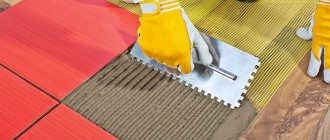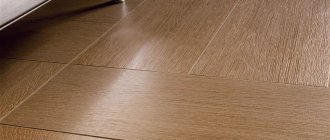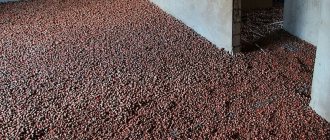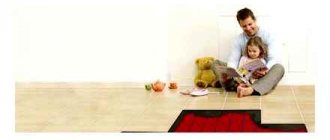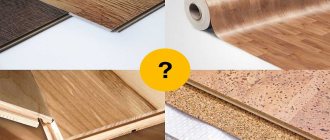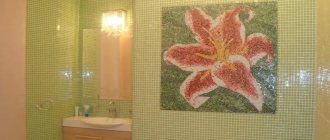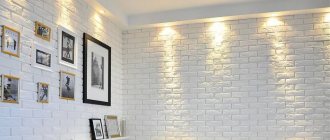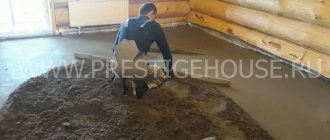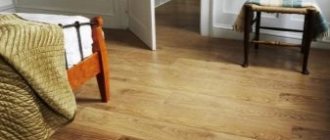Vinyl flooring is intended for domestic and commercial use: home, office, hotels, production and industrial sites, train stations, airports, as well as educational, medical and children's institutions. Depending on the thickness of the protective layer, the floor covering has a wear resistance class of 34-43.
The composition of a modern vinyl floor, as a rule, is dominated by quartz sand or other minerals (70-80%) and contains 1-2 layers of fiberglass. Thanks to this, quartz vinyl is durable, wear-resistant and stable: it can withstand temperature changes, high humidity, retain its dimensions and performance properties at negative temperatures and under the influence of ultraviolet radiation.
Pros and cons of vinyl flooring
The main advantages of quartz vinyl flooring
✔ Moisture resistance. Vinyl flooring remains stable at any level of humidity in the room, and the floor covering cannot become wet or penetrate liquids. The floor can be filled with water and washed as desired - any defects are excluded.
✔ Wear resistance. The top layer of polyurethane with a variety of reinforcing additives in thicknesses from 0.3 mm to 0.7 mm provides resistance to abrasion, scratches, sun fading and cracking.
✔ Variety of decors. The technology of direct photo printing and register embossing is used, which allows you to recreate the texture and relief of wood and natural stone. An even greater resemblance to parquet is given by the chamfer cut along the perimeter or along the long sides of the sheets in some collections.
✔ Easy to care for and unpretentious. PVC tiles do not require special care and specific operating conditions. Wet cleaning and cleaning with a washing vacuum cleaner are allowed. There is no possibility of dust particles getting under the floor: there are no gaps between the slats.
✔ Water resistant. Adhesive quartz vinyl tiles are invulnerable to humidity and direct prolonged contact with water.
✔ Durability. The service life is limited only by the desire to update the interior of the room!
✔ Easy installation. Vinyl flooring is glued to the substrate or installed using durable click locks. However, careful leveling of the base is required first.
Minuses
- Preparing the base. The subfloor must be perfectly level, dry, stable and clean. The slightest imperfections will immediately be reflected in the final floor covering.
- Synthetic material. Despite all the positive qualities of PVC tiles, they are of artificial origin and do not give the feeling of a touch of nature, like parquet boards or cork coverings.
- Lots of fakes. Great demand for practical flooring gives rise to a lot of fakes. Trust famous European and Korean brands!
- Incompatible with rubber. Some types of PVC tiles, when in contact with rubber (for example, rubberized mats), permanently change color and become dull. For most of the quartz vinyl presented in the catalog, this problem does not arise - due to the special surface treatment.
Vinyl floor. Thanks to the protective layer and multilayer structure of PVC, the tiles are practically invulnerable to abrasive wear and mechanical damage, and are also 100% waterproof!
✔ Choose quartz vinyl laminate, adhesive PVC tiles, as well as unique woven vinyl flooring and the latest SPC laminate - a floor without weak points - in the Polov catalog!
SPC Quality Flooring
Our company was one of the first in Belarus to begin selling these composite vinyl floors. At first, these coatings were produced without a brand - SPC Quality Flooring by Kronospan
.
At the moment they are already produced under the main brand - ROCKO
. Here is a review from our customer about this vinyl tile.
Composite vinyl flooring Rocko R078 Air Flow “Built in Uruchye. I decided to try something fresh and modern for my new apartment. I read somewhere about vinyl floors. Having studied the issue in more detail, I settled on “stone vinyl”. There are few reviews about these floors on the Internet, but the store explained everything correctly. Purchased Polish vinyl SPC Quality Flooring Salt Mine. By the way, the price was cheap - the vinyl was on sale. There is nothing to tell about the installation process: not dusty, not noisy, easy and simple. Unlike laminate, stone vinyl does not crumble and can be easily cut with a sharp knife. Now about the pros: the floor is very quiet. When walking, this vinyl makes no sound at all. It is not afraid of water (after all, there is no wood in it). I haven’t had time to test it thoroughly for scratch resistance yet, but it feels like it’s really hard to scratch. Regarding the disadvantages: it is colder than laminate or linoleum. Perhaps that's all. Recommend for purchase? Of course yes." Sadyro Alexey, Minsk
Vinyl flooring by installation type
Adhesive PVC tiles
Installation is carried out using contact adhesive for PVC, on a carefully prepared base. Adhesive quartz vinyl is cheaper than interlocking PVC laminate per m2, but the cost of glue and subfloor preparation should also be taken into account when calculating. Detailed instructions for laying PVC tiles. Use adhesive vinyl tiles for rooms with high humidity and difficult operating conditions.
Certified manufacturers of adhesive-installed vinyl flooring: Decoria, FineFloor, Alpine Floor, Art East, Tarkett, CorkArt, Dumafloor Aquafloor, Concept Floor.
Interlocking quartz vinyl laminate
For installation, durable and easy-to-use click locks are provided. Thanks to the flooring without glue and the increased thickness of the sheets, the floor covering does not require special preparation of the base; small differences are allowed. Step-by-step instructions for laying interlocking PVC laminate. Use interlocking vinyl flooring for rooms with normal humidity and in cases where full use of the coating is required immediately after installation.
Manufacturers represented in the salon: FineFloor, Vinilam, Corkstyle, Alpine Floor, Art East, CorkArt, NOX Ecoclick+, Pergo, Wonderful Vinyl Floor, Moduleo, Egger, Berry Alloc, Dumafloor Aquafloor, Decoria, Concept Floor, Meister.
Wicker Vinyl Flooring
The surface of woven PVC tiles imitates a woven surface: durable polyvinyl chloride threads are intertwined in original and complex patterns. At the same time, the performance characteristics are identical to classic adhesive-type vinyl flooring. Woven vinyl is made in tiles, sheets or rolls and laid with adhesive.
Mineral floor
► Select a mineral floor from the catalog.
This type of flooring is only indirectly related to quartz vinyl floors; it is rather an evolution, the next generation. A rigid mineral board is used as the middle layer, which ensures the strength and water resistance of quartz vinyl. In addition, such a base allows you to avoid the use of plasticizers, which are responsible for the stability of PVC tiles. Thanks to this, mineral flooring is an environmentally friendly, wear-resistant material for rooms under any operating conditions!
We offer mineral flooring only from the best manufacturers: Classen NEO 2.0, Corkstyle Micodur, Art Stone, Aquafloor Quartz, Mineral Plus.
Why do you need a substrate?
It is necessary to install the underlayment because vinyl laminate is a material that is flexible and thin. Because of this, if the floor is uneven, even minor, it can be easily damaged.
When the substrate is arranged, the irregularities disappear. The PVC laminate adheres tightly to the base over the entire area. Due to this, the pressure, which is provided by the weight acting on the lamellas, is distributed evenly. The coating is not damaged.
When choosing an underlay material, it is necessary to take into account that it should protect the laminate from the influence of the base layer from which the floor is made. It could be concrete, fiberboard.
It is necessary to take into account the existing humidity, temperature, as well as the condition of the surface itself - the presence/absence of unevenness and differences in height.
Typical structure of quartz vinyl floor
- The protective layer is a polyurethane coating that determines the class of application and wear resistance of the vinyl floor.
- The decorative layer is a decorative textured film with a specific image.
- The middle layer is vinyl with the addition of quartz sand, with fiberglass on the bottom and top.
- A stabilizing PVC layer is necessary so that the compressed sand does not crumble over time under loads.
- Underlay - provides sound insulation for vinyl flooring and distributes impact loads evenly over the surface.
The structure of vinyl flooring can vary significantly from one manufacturer to another. For example, Vinilam offers a collection of quartz vinyl tiles with an integrated cork backing, Vinilam Prestige. Many manufacturers improve the protective layer by adding ceramic chips, aluminum oxide and even diamond particles.
Base surface requirements
Vinyl flooring is laid on a cement screed, plywood or chipboard, or an old coating if it is tightly attached to the base. Surface requirements:
- Solidity - cracks and depressions in the screed are sealed with cement mortar.
- Compliance with the horizon - the total slope should not exceed 4 mm.
- Cleanliness – the base must be completely free of dirt, dust, chemical liquids, and oil stains.
- Strength – deformation or deflection of the surface under load is not allowed.
- Lack of moisture - the surface must be dry; you will need to wait until the screed or leveling compound has completely dried.
Worn flooring (carpet, parquet, linoleum) is dismantled. Durable ceramic tiles without relief can be left, but filled with leveling mortar. The wooden floor is covered with moisture-resistant plywood or chipboard with a thickness of at least 10 mm.
Pros and cons of vinyl tiles from different manufacturers - links
We offer extensive reviews of the pros and cons of vinyl flooring from selected manufacturers presented in the Polov catalog:
► FineFloor. Belgian-made quartz vinyl laminate of 34 and 43 wear resistance classes with a multilayer structure and realistic decors.
► Decoria. Adhesive PVC tiles made in South Korea. An ideal solution for commercial premises (Office Tile collection).
► Vinyl. Quartz vinyl with adhesive installation or mechanical lock. Made in Belgium.
► Alpine Floor. Performance adhesive and interlocking vinyl flooring for residential and commercial applications.
► IVC Moduleo. Belgian interlocking quartz vinyl tiles with a double layer of fiberglass: stability and durability of the floor covering.
► Aquafloor. Waterproof interlocking and adhesive vinyl flooring made in Belgium.
►Pergo. Wear-resistant quartz vinyl laminate with a reinforced TitanV protective layer 0.55 mm thick and PerfectFold V sealed locking joints. Made in Belgium.
► Art East. Interlocking PVC laminate and adhesive vinyl tiles made in South Korea.
► Corkstyle Vinyline. A collection of vinyl floors from the famous Swiss cork flooring manufacturer Corkstyle.
► Corkart. Concept of quartz vinyl tiles from CorkArt, a cork floor manufacturer from Portugal.
► Tarkett. Russian PVC tiles Art Vinyl with a reinforced protective layer of Extreme Protection.
►Egger. Egger Design+ composite flooring on sealed UWF fibreboard with soundproofing underlay. German production.
Read detailed reviews on the pros and cons of vinyl flooring from each manufacturer to choose the best solution for your space!
Features of operation
The durability and appearance of vinyl flooring depends on operating conditions. For maintenance, dry cleaning with a vacuum cleaner and wet cleaning with detergents that do not contain abrasive particles are allowed. To remove stains, do not use compounds containing chlorine and acetone. The use of biodegradable cleaners is recommended. Prolonged contact between the coating and rubber should not be allowed. The materials react chemically and black spots form on the floor. To restore its decorative appeal, manufacturers recommend rubbing vinyl laminate flooring with a special mastic once a year.
Quartz vinyl in interiors
Step-by-step recommendations
First you need to calculate the number of rows. If necessary, trim the dies so that the first and last rows are the same in width. The tiles must be laid with an offset of each next row relative to the previous one.
Step-by-step technology for laying interlocking vinyl flooring:
- The groove of the end and longitudinal lock must be located on the stacker side. The groove facing the wall is trimmed.
- The first row is laid with the end locks of the tiles snapped into place. Using a mallet and a roller, secure the connection.
- At the end of the first row, you need to cut off the excess length of the die and install the end panel.
- Insert spacers between the wall and the tile at a distance of 5-10 mm to avoid accidental shifting of the lamellas.
- The tiles in the second row must be carefully inserted into the lock of the tiles of the first row at an angle of 25 degrees and smoothly lowered until the lock is completely closed. In this case, you need to shift the lamella of the second row by 25 cm relative to the first. Close the end lock in the same way. To ensure a reliable connection, use a rubber mallet to tap the panel until the cracks disappear. The blows are applied not to the lamella, but to a special bar, this will prevent damage to the coating.
- When laying the last row, you need to adjust the size of the dies in accordance with the markings, and cut off the excess with a special construction knife.
- When laying tiles near pipes and columns, a cardboard pattern is used. It is recommended to outline the shape on paper and, applying it to the tile, cut out the holes according to this template.
Important: the quality of laying the coating itself depends on the quality of the connection of the locks.


